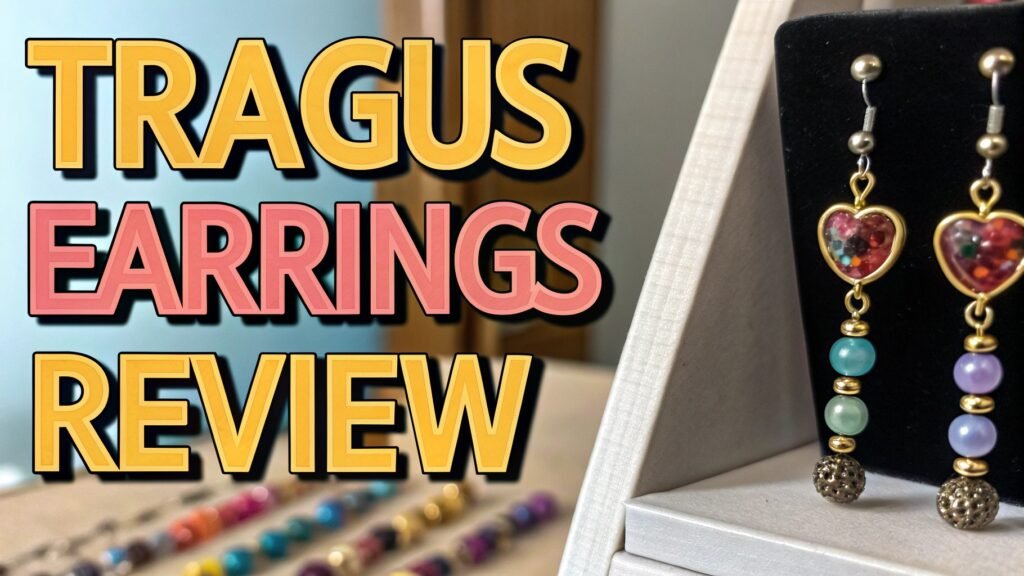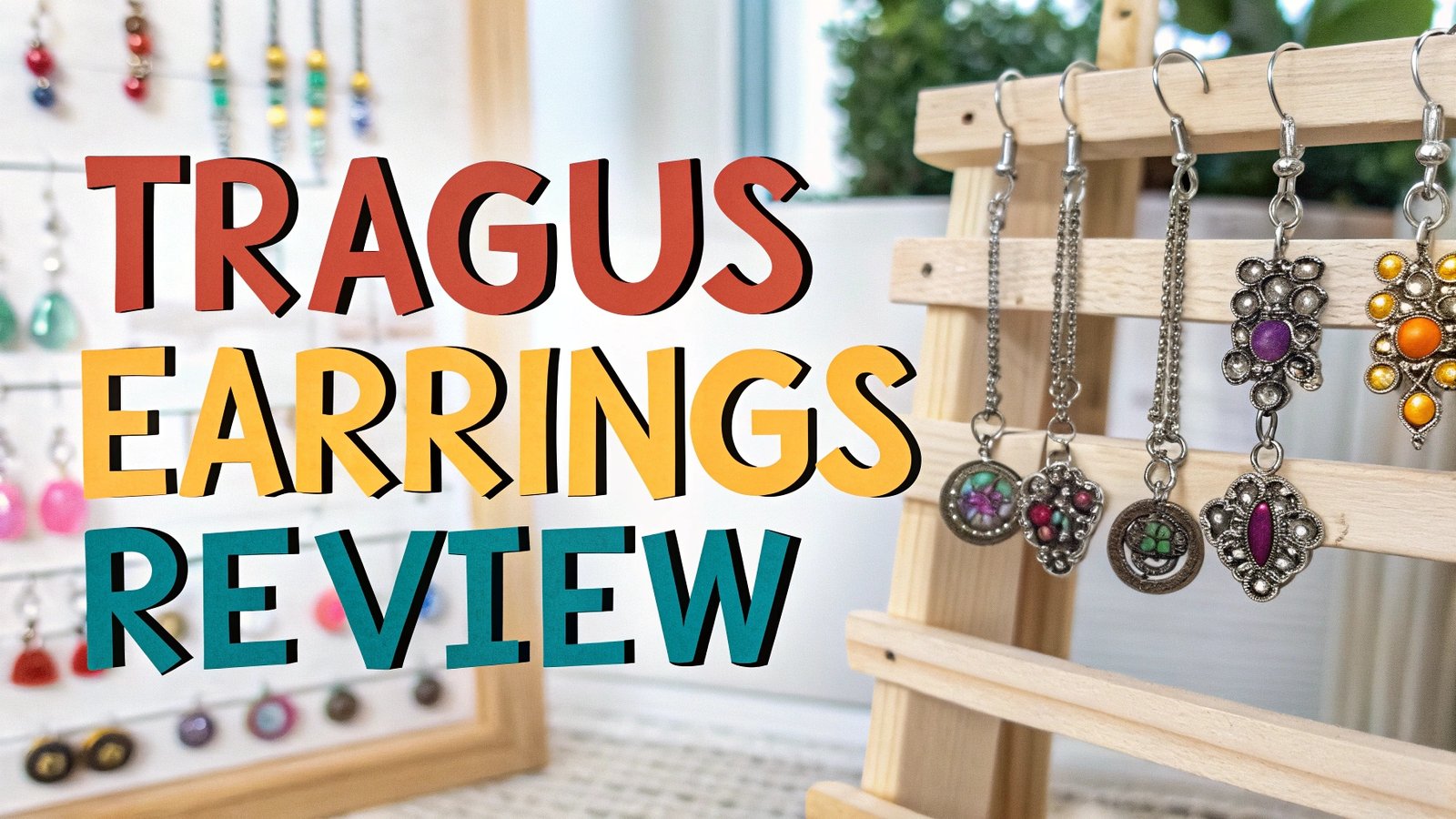Tragus Earrings Review: Choose the Perfect Jewelry
Are you considering getting a tragus piercing or looking to upgrade your current tragus jewelry?
This comprehensive guide will walk you through everything you need to know about tragus earrings.
From understanding different materials to finding the perfect fit, we will cover all the essential aspects that make tragus earrings a popular choice for ear enthusiasts.

Key Takeaways
- Material Quality Matters: Titanium and surgical steel are the safest options for tragus earrings, especially for new piercings. These materials reduce the risk of allergic reactions and promote faster healing.
- Size Selection is Critical: Most tragus piercings use 16g or 18g jewelry with lengths ranging from 6mm to 8mm. Proper sizing ensures comfort and prevents complications during healing.
- Healing Process Takes Time: Tragus piercings typically take 3-6 months to heal completely. During this period, quality jewelry and proper aftercare are essential for successful healing.
- Style Options Are Endless: From simple studs to decorative hoops, tragus earrings come in various styles to match any aesthetic preference or lifestyle need.
- Professional Piercing is Essential: Always get your tragus pierced by a professional piercer using sterile equipment and high-quality jewelry to ensure the best results.
Understanding Tragus Earrings
The tragus is a small, thick piece of cartilage that protrudes from the side of your ear. This unique anatomical feature makes it an excellent location for jewelry placement. Tragus earrings are specifically designed to fit comfortably in this area while providing both style and functionality.
Unlike traditional earlobe piercings, tragus piercings require special consideration due to the cartilage structure. The cartilage is denser and less flexible than soft tissue, which means healing takes longer and requires more careful attention to jewelry selection.
Professional piercers recommend starting with high-quality jewelry to ensure proper healing. The initial jewelry should be slightly longer to accommodate swelling, then replaced with a better-fitting piece once healing is complete. This approach helps prevent complications and ensures the best possible outcome for your new piercing.
Most people find tragus piercings to be moderately painful during the piercing process, with pain levels typically ranging from 4-6 on a scale of 1-10. The pain is usually brief and manageable, making it a popular choice for those looking to add something special to their ear jewelry collection.
Types of Tragus Earrings
There are several distinct types of tragus earrings, each offering different aesthetic and functional benefits. Understanding these options will help you choose the perfect piece for your needs and preferences.
Flat-back studs are the most popular choice for tragus piercings. These earrings feature a decorative front with a flat disc backing that sits flush against the inside of your ear. This design minimizes irritation and provides maximum comfort during daily activities. The flat back also reduces the risk of the jewelry catching on clothing or hair.
Threadless or push-fit jewelry has gained popularity among piercing enthusiasts. These pieces feature a post that slightly bends when inserted, creating a secure fit without requiring threading. This design makes jewelry changes easier and reduces the risk of cross-threading, which can damage both the jewelry and your piercing.
Hoops and rings offer a more dramatic look for healed tragus piercings. These pieces come in various diameters, typically ranging from 5mm to 8mm. Seamless rings and captive bead rings are popular choices that provide a classic, timeless appearance while allowing for easy cleaning and maintenance.
Curved barbells are another option, though they are less common for tragus piercings. These pieces feature a slight curve that follows the natural contour of your ear, providing a unique look while maintaining comfort and functionality.
Materials and Quality
The material of your tragus earrings plays a crucial role in both comfort and healing success. High-quality materials not only look better but also reduce the risk of complications and allergic reactions.
Titanium is widely considered the gold standard for body jewelry. This material is biocompatible, lightweight, and hypoallergenic, making it ideal for sensitive skin. Implant-grade titanium (ASTM F136) is the highest quality option available and is used in medical implants, ensuring safety and compatibility with your body.
Surgical steel (316L or 316LVM) is another excellent choice for tragus earrings. This material is durable, affordable, and resistant to corrosion. However, it does contain small amounts of nickel, which may cause reactions in highly sensitive individuals.
Solid gold (14k or 18k) is a premium option that offers both beauty and biocompatibility. Gold jewelry is less likely to cause allergic reactions and maintains its appearance over time. However, it is more expensive than other materials and requires proper care to prevent damage.
Niobium is a lesser-known but excellent material for sensitive skin. It is completely hypoallergenic and can be anodized to create various colors without compromising safety. While not as common as titanium or steel, niobium is an excellent choice for those with severe metal sensitivities.
Sizing and Fit
Proper sizing is essential for both comfort and healing success. Incorrect sizing can lead to complications, discomfort, and prolonged healing times.
Gauge size refers to the thickness of the jewelry post. Most tragus piercings are done with 16g (1.2mm) or 18g (1.0mm) jewelry. Some piercers prefer 16g for its durability and easier jewelry selection, while others use 18g for a more delicate appearance.
Length is equally important for proper fit. Initial jewelry should be 6mm to 8mm in length to accommodate swelling during healing. Once healed, you can switch to a shorter post (typically 6mm) for a more comfortable fit that does not protrude from your ear.
Professional measurement is recommended to ensure proper sizing. A qualified piercer can assess your anatomy and recommend the best size for your specific ear structure. This personalized approach helps prevent issues and ensures the most comfortable fit possible.
The diameter for hoops typically ranges from 5mm to 8mm, depending on your anatomy and personal preference. Smaller diameters create a snug fit, while larger ones provide a more dramatic appearance. Your piercer can help determine the best size for your desired look.
Top 3 Alternatives for Tragus Earrings
Best Tragus Earring Brands
Several brands have established themselves as leaders in the tragus earring market, offering high-quality materials, innovative designs, and reliable customer service.
Anatometal is widely regarded as one of the premier body jewelry manufacturers. Their pieces are made from implant-grade materials and feature precise manufacturing standards. While more expensive than mass-produced alternatives, Anatometal jewelry is built to last and provides excellent value for serious piercing enthusiasts.
Industrial Strength is another top-tier brand known for its innovative designs and quality construction. They offer a wide range of styles and materials, including unique options like colored titanium and specialty gems. Their jewelry is popular among professional piercers and collectors alike.
Neometal has gained popularity for its threadless jewelry systems and high-quality materials. Their pieces feature smooth finishes and precise fits, making them comfortable for daily wear. The brand offers both basic and decorative options to suit various preferences and budgets.
BVLA (Body Vision Los Angeles) specializes in luxury body jewelry with intricate designs and precious materials. Their pieces often feature genuine gemstones and detailed craftsmanship, making them perfect for special occasions or as investment pieces.
Tragus Earring Styles
The variety of tragus earring styles available today means there is something to suit every taste and lifestyle preference.
Minimalist studs remain the most popular choice for everyday wear. These simple pieces feature clean lines and understated elegance, making them suitable for professional environments and casual settings alike. Common designs include small gems, simple balls, and geometric shapes.
Decorative tops offer more visual interest while maintaining comfort and practicality. These pieces might feature intricate patterns, multiple gems, or unique shapes that add personality to your look. Popular designs include flowers, stars, and abstract patterns.
Statement pieces are perfect for those who want their tragus jewelry to be a focal point. These bold designs might feature large gems, unique shapes, or eye-catching colors. While not suitable for everyone, statement pieces can create a dramatic and memorable look.
Matching sets allow you to coordinate your tragus jewelry with other ear piercings. Many brands offer coordinated collections that include studs, hoops, and other pieces designed to work together harmoniously.
Tragus Piercing Process
Understanding the piercing process helps you prepare for your appointment and know what to expect during and after the procedure.
Consultation is the first step in getting a tragus piercing. Your piercer will assess your anatomy, discuss jewelry options, and explain the healing process. This is also an opportunity to ask questions and address any concerns you might have.
Preparation involves cleaning the area and marking the piercing location. Your piercer will use sterile equipment and follow strict hygiene protocols to ensure your safety. The marking allows you to approve the placement before the actual piercing.
The piercing procedure typically takes just a few seconds. Most piercers use a hollow needle to create a clean puncture, followed by immediate jewelry insertion. The process is quick but can be moderately painful due to the cartilage structure.
Immediate aftercare begins right after the piercing. Your piercer will provide detailed instructions and may apply a protective bandage. Initial swelling is normal and should subside within a few days with proper care.
Pain and Healing
Pain levels and healing times vary among individuals, but understanding what to expect can help you prepare and manage the process effectively.
Pain during piercing is typically described as a sharp, quick sensation followed by throbbing. Most people rate tragus piercing pain as moderate, around 4-6 on a 10-point scale. The pain is brief and manageable with proper breathing techniques and relaxation.
Healing timeline for tragus piercings is generally 3-6 months for complete healing. The initial healing phase lasts about 4-6 weeks, during which you should avoid changing jewelry or putting pressure on the area. Full healing allows for jewelry changes and normal activities.
Factors affecting healing include your overall health, age, lifestyle, and adherence to aftercare instructions. Proper nutrition, adequate sleep, and stress management all contribute to faster healing. Avoiding alcohol, smoking, and unnecessary touching also promotes better healing outcomes.
Signs of proper healing include decreased swelling, reduced tenderness, and the absence of discharge or unusual odors. The area should gradually become less sensitive and more comfortable over time.
Aftercare and Maintenance
Proper aftercare is essential for preventing complications and ensuring successful healing of your tragus piercing.
Daily cleaning should be performed twice daily using a saline solution or piercing aftercare product. Avoid using alcohol, hydrogen peroxide, or other harsh chemicals that can irritate the healing tissue. Gentle cleaning with a cotton swab or clean cloth is sufficient.
Lifestyle modifications during healing include avoiding sleeping on the pierced side, not wearing headphones or earbuds, and being careful when washing your hair. These precautions help prevent irritation and trauma to the healing piercing.
Signs of infection include increased redness, swelling, heat, and discharge with an unusual odor. Persistent pain or fever may also indicate problems. If you notice any of these symptoms, contact your piercer or healthcare provider immediately.
Long-term care involves regular cleaning and inspection of your jewelry. Annual checkups with your piercer can help identify potential issues early and ensure your jewelry remains in good condition.
Troubleshooting Common Issues
Even with proper care, some people experience issues with their tragus piercings. Understanding common problems and their solutions can help you address them quickly.
Irritation bumps are small, raised areas that can develop around the piercing. These are usually caused by trauma, poor jewelry quality, or overcleaning. Treatment involves identifying and eliminating the cause, often requiring jewelry changes or modified aftercare routines.
Jewelry rejection occurs when your body attempts to push out the jewelry. This can happen due to poor jewelry quality, incorrect sizing, or individual body chemistry. Early intervention with jewelry changes or professional consultation can often resolve this issue.
Slow healing may result from various factors including poor aftercare, low-quality jewelry, or individual health factors. Consistent care and patience are usually required, though professional evaluation may be necessary in some cases.
Jewelry-related problems such as threading issues, loose tops, or damaged pieces should be addressed promptly. Regular inspection of your jewelry helps identify problems early and prevents more serious complications.
Cost Considerations
The cost of tragus earrings varies widely based on materials, brands, and design complexity. Understanding these factors helps you make informed decisions about your jewelry investment.
Budget options typically range from $10-30 and include basic surgical steel or titanium pieces. These are suitable for initial piercings and everyday wear, though quality and design options may be limited.
Mid-range jewelry ($30-100) offers better materials, more design options, and improved durability. This price range includes quality titanium pieces, basic gold jewelry, and branded options from reputable manufacturers.
Premium pieces ($100-500+) feature high-end materials, intricate designs, and superior craftsmanship. These might include solid gold pieces, genuine gemstones, or limited edition designs from luxury brands.
Long-term value should be considered when choosing jewelry. Quality pieces may cost more initially but provide better comfort, durability, and appearance over time. This can result in lower overall costs compared to frequently replacing cheaper jewelry.
Seasonal and Fashion Trends
Tragus earring trends evolve with fashion and seasons, offering opportunities to update your look and express your personal style.
Current trends include minimalist designs, mixed metals, and asymmetrical arrangements. Many people are choosing to combine different styles and materials to create unique, personalized looks that reflect their individual aesthetic.
Seasonal considerations might influence your jewelry choices. Lighter, more delicate pieces are popular in spring and summer, while richer materials and warmer tones are favored in fall and winter. Holiday seasons often see increased interest in gemstone and precious metal pieces.
Fashion coordination allows you to match your tragus jewelry with other accessories or clothing styles. Many people choose jewelry that complements their overall aesthetic, whether that is bohemian, minimalist, edgy, or classic.
Investment pieces transcend seasonal trends and provide lasting value. Classic designs in quality materials remain stylish year after year, making them excellent choices for those who prefer timeless elegance over trendy pieces.
Future of Tragus Earrings
The tragus earring market continues to evolve with new materials, technologies, and design innovations.
Material innovations include new alloys, surface treatments, and biocompatible options that provide improved comfort and safety. Smart materials that respond to temperature or pH changes are being explored for future applications.
Design technology such as 3D printing and CAD modeling allows for more precise and complex designs. This technology enables custom pieces and rapid prototyping of new styles, expanding options for consumers.
Sustainability trends are influencing jewelry manufacturing, with increased focus on recycled materials, ethical sourcing, and environmentally friendly production methods. This shift appeals to environmentally conscious consumers.
Personalization options are becoming more accessible, allowing individuals to create custom designs that reflect their unique style and preferences. This trend toward individualization is likely to continue growing in popularity.
Frequently Asked Questions
How long do tragus piercings take to heal?
Tragus piercings typically take 3-6 months to heal completely. The initial healing phase lasts about 4-6 weeks, during which you should avoid changing jewelry or putting pressure on the area. Full healing allows for jewelry changes and normal activities without discomfort.
What size jewelry should I use for my tragus piercing?
Most tragus piercings use 16g or 18g jewelry with lengths ranging from 6mm to 8mm. Initial jewelry should be slightly longer to accommodate swelling, then replaced with a better-fitting piece once healed. Professional measurement ensures the best fit for your anatomy.
Can I sleep on my tragus piercing?
You should avoid sleeping on your tragus piercing during the healing process, which typically lasts 3-6 months. Sleeping on the piercing can cause irritation, prolonged healing, and potential complications. Consider using a travel pillow or sleeping on the opposite side.
What materials are best for tragus earrings?
Titanium and surgical steel are the safest options for tragus earrings, especially for new piercings. These materials are biocompatible, hypoallergenic, and reduce the risk of allergic reactions. Solid gold (14k or 18k) is also an excellent choice for those who prefer precious metals.
How much does a tragus piercing cost?
Tragus piercing costs vary by location and piercer experience, typically ranging from $40-100 for the piercing service. Jewelry costs additional and can range from $10-500+ depending on materials and design complexity. Quality jewelry is worth the investment for comfort and healing success.
Can I change my tragus jewelry myself?
While you can change healed tragus jewelry yourself, it is recommended to have a professional piercer perform the first few changes. They can ensure proper technique, assess healing progress, and recommend appropriate jewelry options. Once comfortable with the process, you can make future changes independently.
Hi i’m Mia Jenkins a fashion trend expert with a passion for self-expression and creativity. With a keen eye for style and a deep understanding of the latest trends.







